Please set your exam date
Newborn Reflexes
Study Questions
Sucking/Rooting Reflex
A nurse is assessing a newborn’s neurologic function by eliciting the sucking and rooting reflex.
Which of the following actions should the nurse take to elicit this reflex?
Explanation
This action will elicit therooting reflex, which helps the newborn find the breast or bottle nipple for feeding.Thesucking reflexoccurs after the rooting reflex, when the roof of the newborn’s mouth is stimulated by the nipple.
A nurse is observing a newborn who is lying on their back.
The nurse notices that when the newborn turns their head to the right, they extend their right arm and leg and flex their left arm and leg.
The nurse recognizes this as which of the following reflexes?
Explanation
This reflex is also called the “fencing” reflex because of the position of the hands.
When a baby’s head is turned to one side, the arm on that side stretches out and the opposite arm bends up at the elbow.This reflex lasts until the baby is about 5 to 7 months old.
Palmer Grasp Reflex
A nurse is assessing the palmer grasp reflex of a 4-month-old infant.
Which of the following actions should the nurse take?
Explanation
thepalmar grasp reflexis a primitive and involuntary reflex found in infants of humans and most primates that causes them to close their fist around anything placed in their palm.The reflex is present at birth and persists until 4 to 6 months of age.The reflex helps the baby learn to grip and hold onto things with their hands.
A nurse is teaching a group of parents about the normal development of infant reflexes.
Which of the following statements by a parent indicates an understanding of the teaching?
Explanation
This reflex is elicited by placing an object in the infant’s palm and the infant will curl their fingers around it.
This reflex helps the infant to develop voluntary grasping skills later on.
Plantar Grasp Reflex
A nurse is assessing a newborn’s plantar grasp reflex.
Which of the following actions should the nurse take to elicit this reflex?
Explanation
The nurse should place a finger under the toes and observe for curling.
This is the plantar grasp reflex, which is an involuntary movement that newborns make when their feet are stimulated.The reflex is present at birth and disappears between 9 to 12 months of age.
A nurse is caring for a 6-month-old infant who has a plantar grasp reflex.
The nurse should recognize that this reflex is
Explanation
The plantar grasp reflex is an involuntary movement of the toes when the sole of the foot is stimulated.It is usually present at or soon after birth and disappears between 6 and 12 months of age.
It is a sign of normal development and function of the spinal cord and brain.
Moro Reflex/Startle Reflex
A nurse is assessing a newborn baby for the presence of the Moro reflex.
Which of the following actions should the nurse perform to elicit this reflex?
Explanation
This will elicit the Moro reflex, which is a normal, involuntary reaction that newborns and infants have when they’re startled.When something triggers the Moro reflex, a baby will extend their arms — moving them outward at the shoulder and then straightening them — and throw their head back.A few seconds later, the arms will naturally come back down and in towards the body.
A client asks a nurse why their baby exhibits the Moro reflex when they hear a loud noise.
Which of the following responses should the nurse give?
Explanation
The Moro reflex is a startle reflex that occurs when a baby hears a loud noise or feels a sudden movement.It causes the baby to throw back his or her head, extend out his or her arms and legs, cry, then pull the arms and legs back in.It is a normal reflex that shows the baby’s nervous system is working well and it usually disappears by 4 months of age.
Tonic Neck Reflex
A nurse is assessing a newborn’s reflexes.
Which of the following actions by the nurse would elicit the tonic neck reflex?
Explanation
Turning the newborn’s head to one side while in a supine position would elicit the tonic neck reflex.This reflex is also known as the fencing reflex because the newborn assumes a posture similar to that of a fencer, with one arm and leg extended on the side to which the head is turned and the opposite arm and leg flexed.This reflex is present at birth and disappears by 3 to 4 months of age.
A nurse is teaching a group of parents about infant reflexes.
Which of the following statements by one of the parents indicates an understanding of the teaching? (Select all that apply.)
Explanation
These statements reflect an understanding of the infant reflexes.
The rooting reflex helps the baby locate the nipple for feeding.
The Moro reflex is a startle response that causes the baby to extend the arms and legs and then flex them back.
The Babinski reflex is a normal response in infants where the big toe extends and the other toes fan out when the sole of the foot is stroked.
Babinski's Reflex
A nurse is assessing a 6-month-old baby’s reflexes.
Which of the following actions should the nurse perform to elicit the Babinski’s reflex?
Explanation
To elicit the Babinski’s reflex, the nurse should stroke the outer edge of the baby’s sole from heel to toe.The Babinski’s reflex is a normal response in infants and young children until they are about 6 months to 2 years old.It involves the big toe bending up and back and the other toes spreading out.The reflex can indicate a neurological problem in adults if it is present.
A nurse is caring for a client who has a spinal cord injury at the level of T12.
The nurse observes an extensor response when stroking the client’s foot.
How should the nurse document this finding?
Explanation
an extensor response (big toe bending up and back and other toes spreading out) when stroking the foot is normal in infants and young children, but abnormal in adults and older children.It indicates a problem in the cortical spinal tract, which is responsible for motor control.
Stepping Reflex
A nurse is assessing a newborn’s reflexes.
The nurse places an object in the newborn’s palm and observes that the newborn grasps it.
What is this reflex called?
Explanation
This reflex is triggered when an object is placed in the newborn’s palm and the baby closes his or her fingers around it.This reflex lasts until the baby is about 5 to 6 months old.
A nurse is holding a newborn upright with his feet touching a flat surface.
The nurse notices that the newborn makes stepping movements as if walking.
The nurse knows that this reflex is present from birth to 4 weeks and is called:
Explanation
The stepping reflex is a newborn reflex that occurs when a baby is held upright with their feet touching a flat surface.
The baby makes stepping movements as if walking.This reflex is present from birth to 4 weeks.
Nursing Interventions
A nurse is assessing a newborn’s reflexes as part of a routine examination.
Which of the following reflexes should the nurse expect to disappear by 3 months of age?
Explanation
The rooting reflex is a survival instinct that helps the baby find and latch onto a nipple to feed.This reflex starts when the corner of the baby’s mouth is stroked or touched, and the baby turns his or her head and opens his or her mouth to follow and root in the direction of the stroking.This reflex lasts about 4 months.
A nurse is educating a new mother about the benefits of skin-to-skin contact with her newborn.
Which of the following statements by the mother indicates an understanding of the teaching? (Select all that apply.)
Explanation
These statements indicate an understanding of the teaching because they reflect the benefits of skin-to-skin contact with the newborn.According to various sources, skin-to-skin contact can help the baby develop his sucking reflex, keep the baby warm and comfortable, enhance the baby’s bonding with the mother, and stimulate the baby’s brain development.
A nurse is observing a newborn for signs of neonatal neck righting reflex.
The nurse gently turns the newborn’s head to one side and observes the response.
What should the nurse expect to see if the reflex is present?
Explanation
the neonatal neck righting reflex is triggered by stretching of the neck muscles when there is rotation of the head or movement of the cervical/neck spine.This reflex is present at birth in a normal full term baby and strongest at about three months of age.
Summary
A nurse is performing a routine assessment on a newborn.
The nurse gently drops the head of the newborn while supporting the body and observes symmetric abduction and extension of the arms followed by flexion and adduction of the arms.
This finding indicates a positive response for which of the following reflexes?
Explanation
This reflex is also known as the startle reflex and it is a protective reaction to a loud noise or sudden movement.When an abrupt sound startles the baby or their head falls backward, they extend their arms and legs, then flex and adduct their arms.
A nurse is assessing a newborn’s reflexes as part of a neurologic examination.
The nurse strokes the outer edge of the sole of the newborn’s foot from heel to toe and observes that the newborn’s toes fan upward and out.
The nurse documents this as a positive response for which of the following reflexes?
Explanation
This is a normal reflex in newborns that disappears by 12 to 18 months of age.
It indicates that the nervous system is developing properly.
The Babinski reflex is elicited by stroking the outer edge of the sole of the foot from heel to toe and observing the movement of the toes.
A nurse is performing a routine assessment on a newborn.
The nurse strokes the cheek of the newborn and notes that the newborn turns toward that side and opens his mouth.
The nurse documents this finding as which of the following?
Explanation
This reflex starts when the corner of the baby’s mouth is stroked or touched.
The baby will turn his or her head and open his or her mouth to follow and root in the direction of the stroking.This helps the baby find the breast or bottle to start feeding.This reflex lasts about 4 months.
A nurse is caring for a 2-month-old infant who has a positive Moro reflex.
Which of the following actions should the nurse take to elicit this reflex? (Select all that apply.)
Explanation
To elicit the Moro reflex, the nurse should hold the infant in a semi-sitting position and let the head drop back slightly.This will simulate the sensation of falling and trigger the reflex, which involves spreading out the arms, pulling them in, and crying
A nurse is performing a neurological assessment on a newborn.
Which of the following reflexes should disappear by 8 months of age? (Select all that apply.)
Explanation
The Moro reflex, Babinski reflex and palmar grasp reflex are all newborn reflexes that should disappear by 8 months of age.These reflexes are involuntary responses to certain stimuli that indicate the normal development and function of the brain and nervous system.
A nurse is teaching a group of parents about infant reflexes.
Which of the following statements by a parent indicates an understanding of the teaching?
Explanation
This statement indicates an understanding of the teaching because it accurately describes the duration of the plantar grasp reflex in infants.
The plantar grasp reflex is when the toes flex and adduce when the sole of the foot is stimulated.It is usually present at or soon after birth and disappears between 6 and 12 months of age.
A nurse is teaching a group of new parents about infant reflexes.
Which of the following statements should the nurse include in the teaching? (Select all that apply.)
Explanation
The Moro reflex, or startle reflex, is an involuntary response to a sudden loss of support or a loud noise that involves spreading and curling the arms and legs.
The Moro reflex involves three distinct components: spreading out the arms (abduction), pulling the arms in (adduction), and crying (usually). The baby may also extend and flex their legs.
The Moro reflex can be used to assess the integrity of the baby’s nervous system, as it reflects the development and function of the brain stem. Absence, asymmetry, or persistence of the Moro reflex may indicate neurological problems.
A nurse is evaluating a 3-month-old baby for developmental milestones.
Which of the following findings should the nurse report to the provider as a possible concern?
Explanation
Smiling at familiar faces is a social and emotional milestone that a 3-month-old baby should be able to achieve.
It indicates that the baby recognizes and responds to people they know and trust.A lack of smiling or eye contact may be a sign of developmental delay or autism spectrum disorder.
A nurse is observing an infant who is lying on his back.
The nurse notices that when the infant’s head is turned to the right, his right arm and leg extend, while his left arm and leg flex.
The nurse recognizes this as which of the following reflexes?
Explanation
This is a normal reflex that is present in newborns and disappears by 4 to 6 months of age.It is also known as the fencing reflex because the infant assumes a position similar to a fencer when the head is turned to one side.
A nurse is performing a neurological assessment on a 4-month-old infant.
The nurse gently drops the infant’s head backward while supporting the body.
The nurse expects to see which of the following responses as part of a normal reflex?
Explanation
This is part of theMoro reflex, also called the startle reflex, which is normally present in infants up to about 4 to 6 months old.The reflex is triggered by a loud sound, a sudden movement, or a change in temperature, and causes the baby to throw back his or her head, extend his or her arms and legs, and then pull them back in.
A nurse is performing a neurological examination on a client who has a history of multiple sclerosis.
The nurse notices that the client has difficulty walking and maintaining balance.
Which of the following tests should the nurse use to assess the client’s coordination?
Explanation
The nurse should use all of these tests to assess the client’s coordination, as they are part of a neurological exam for people with MS.
A nurse is evaluating a client who has a suspected stroke.
The nurse asks the client to stick out his tongue and observes that it deviates to the left side.
Which of the following cranial nerves is most likely affected?
Explanation
The hypoglossal nerve controls the movement of the tongue.If this nerve is damaged, the tongue will deviate to the side of the lesion when protruded.
A nurse is performing a routine check-up on a 2-month-old infant.
The nurse gently drops the infant from one hand to the other and observes that the infant’s arms and legs symmetrically extend, then abduct while fingers spread to form a C-shape.
The nurse identifies this as:
Explanation
The Moro reflex, or startle reflex, is a newborn reflex that occurs when a baby is startled by a loud noise or sudden movement.The baby responds by extending and abducting the arms and legs, spreading the fingers to form a C-shape, and then bringing the arms and legs back to the chest.This reflex is present at birth and disappears by 3 to 6 months of age.
A nurse is evaluating an infant’s neuromuscular development by testing different reflexes.
The nurse strokes the outer edge of the sole of the infant’s foot up toward the toes and observes that the infant’s toes fan upward and out.
The nurse documents this as:
Explanation
This is a newborn reflex that occurs when the infant is startled by a loud noise or a sudden movement.The infant’s arms and legs symmetrically extend, then abduct while fingers spread to form a C-shape.This reflex helps the infant cling to the mother in case of a threat.
A nurse is observing a newborn’s reactions to different stimuli.
The nurse touches the corner of the newborn’s mouth with a finger and sees that the newborn turns her head toward that side and starts to suck.
The nurse recognizes this as:
Explanation
This reflex starts when the corner of the baby’s mouth is stroked or touched.
The baby will turn his or her head and open his or her mouth to follow and root in the direction of the stroking.This helps the baby find the breast or bottle to start feeding.
Exams on Newborn Reflexes
Custom Exams
Login to Create a Quiz
Click here to loginLessons
 Naxlex
Just Now
Naxlex
Just Now
Notes Highlighting is available once you sign in. Login Here.
Objectives
-
Understand the purpose and significance of newborn reflexes.
-
Identify and describe the characteristics of common newborn reflexes.
-
Explain the timeline and developmental milestones associated with each reflex.
-
Demonstrate knowledge of nursing interventions related to newborn reflexes.
-
Recognize abnormal findings or variations in newborn reflexes.
-
Apply knowledge of newborn reflexes to provide appropriate care and support.
Introduction: Newborn reflexes are involuntary movements or responses that occur automatically in infants in response to specific stimuli. These reflexes are essential for the survival and development of the newborn. Understanding these reflexes is crucial for healthcare providers to assess the neurologic status of newborns and identify any abnormalities. In this section, we will discuss the various newborn reflexes, their characteristics, developmental timeline, and nursing interventions associated with each reflex.
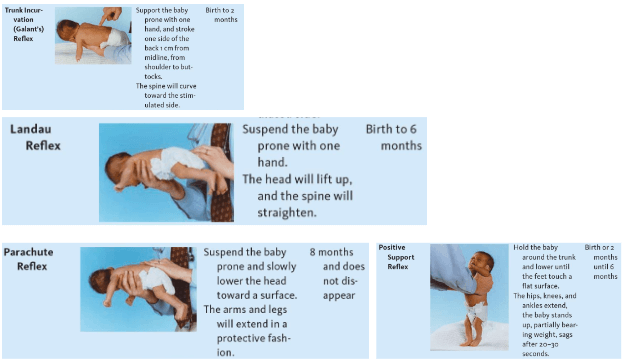
Palmer Grasp Reflex
-
Definition: When an object is placed in the palm of the baby's hand, they automatically grasp it.
-
Timeline: Birth to 6 months.
-
Example: Placing a finger in the baby's palm should elicit the palmer grasp reflex, demonstrating the normal development of the reflex.
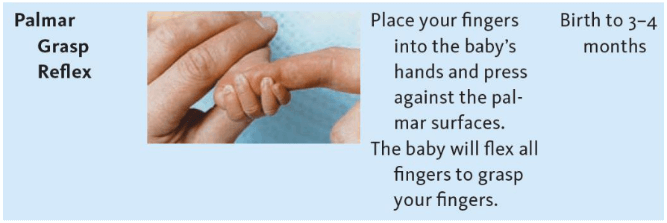
Plantar Grasp Reflex
-
Definition: When the sole of the baby's foot is touched, they curl their toes downwards.
-
Timeline: Birth to 8 months.
-
Example: Gently stroking the baby's foot along the sole should evoke the plantar grasp reflex, indicating normal neurologic function.

Moro Reflex/Startle Reflex
-
Definition: When the baby is suddenly startled or experiences a sudden movement, they extend their arms and legs and then bring them back to their body.
-
Timeline: Birth to 4 months.
-
Example: By gently lowering the baby's head backward while supporting the body, you can observe the Moro reflex, which demonstrates a healthy startle response.
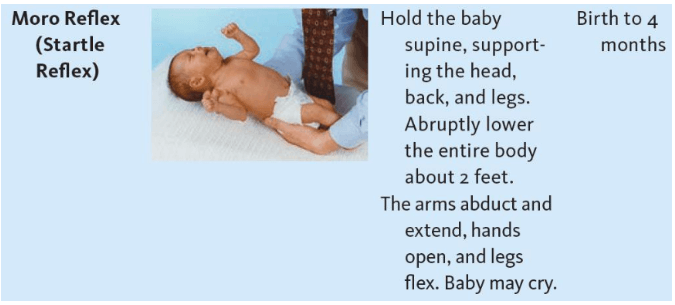
Tonic Neck Reflex
-
Definition: When the baby's head is turned to one side, the arm and leg on that side extend, while the opposite arm and leg flex.
-
Timeline: Birth to 3-4 months.
-
Example: While the baby is in a supine position, turn their head to one side, and observe the extension of the arm and leg on that side and the flexion of the opposite arm and leg, indicating the tonic neck reflex.
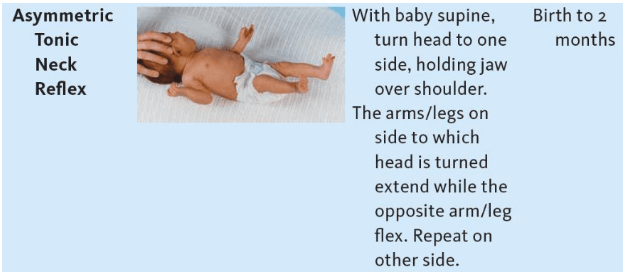
Babinski's Reflex
-
Definition: When the outer edge of the baby's sole is stroked, their toes fan out and curl upward.
-
Timeline: Birth to 1 year.
-
Example: Gently stroking the outer edge of the baby's foot should result in the fanning of the toes, which indicates a normal Babinski's reflex.
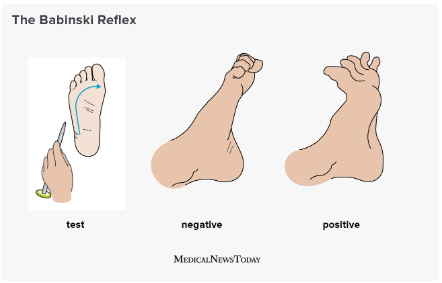
Stepping Reflex
-
Definition: When the baby's feet touch a flat surface, they make stepping movements as if walking.
-
Timeline: Birth to 4 weeks.
-
Example: Holding the baby upright and allowing their feet to touch a flat surface should trigger the stepping reflex, indicating appropriate neuromuscular development.
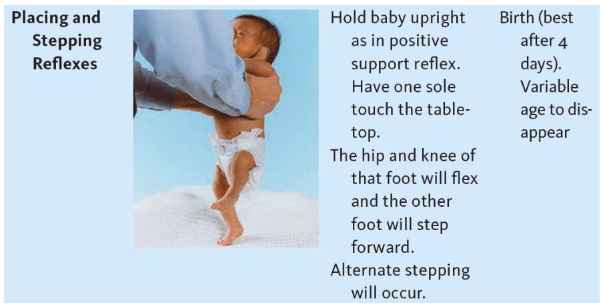
Nursing Interventions
-
Assess and document the presence or absence of newborn reflexes.
-
Educate parents and caregivers about the purpose and normal development of newborn reflexes.
-
Provide a safe and conducive environment for newborns to explore and develop their reflex abilities.
-
Support and encourage parents to engage in activities that promote the development of newborn reflexes, such as skin-to-skin contact and gentle stimulation.
-
Monitor for any abnormal or absent reflexes, which may indicate underlying neurological or developmental issues.
-
Collaborate with the healthcare team to initiate appropriate interventions or referrals for further evaluation if abnormal reflexes are identified.
Conclusion
Newborn reflexes play a vital role in assessing the neurologic status and development of infants. Understanding the characteristics, timeline, and nursing interventions related to these reflexes is essential for healthcare providers working with newborns. By recognizing and appropriately addressing abnormal findings or variations in newborn reflexes, healthcare professionals can ensure optimal care and support for newborns and their families.
Summary
-
Newborn reflexes are involuntary movements or responses that occur automatically in infants.
-
Common newborn reflexes include the sucking/rooting reflex, palmer grasp reflex, plantar grasp reflex, Moro/startle reflex, tonic neck reflex, Babinski's reflex, and stepping reflex.
-
Each reflex has a specific timeline and developmental milestones.
-
Nursing interventions include assessing and documenting reflexes, educating parents, providing a safe environment, and monitoring for abnormal findings.
-
Abnormal reflexes may require further evaluation and intervention.
-
Understanding newborn reflexes is crucial for assessing neurologic function and providing appropriate care.
Naxlex
Videos
Login to View Video
Click here to loginTake Notes on Newborn Reflexes
This filled cannot be empty
Join Naxlex Nursing for nursing questions & guides! Sign Up Now


